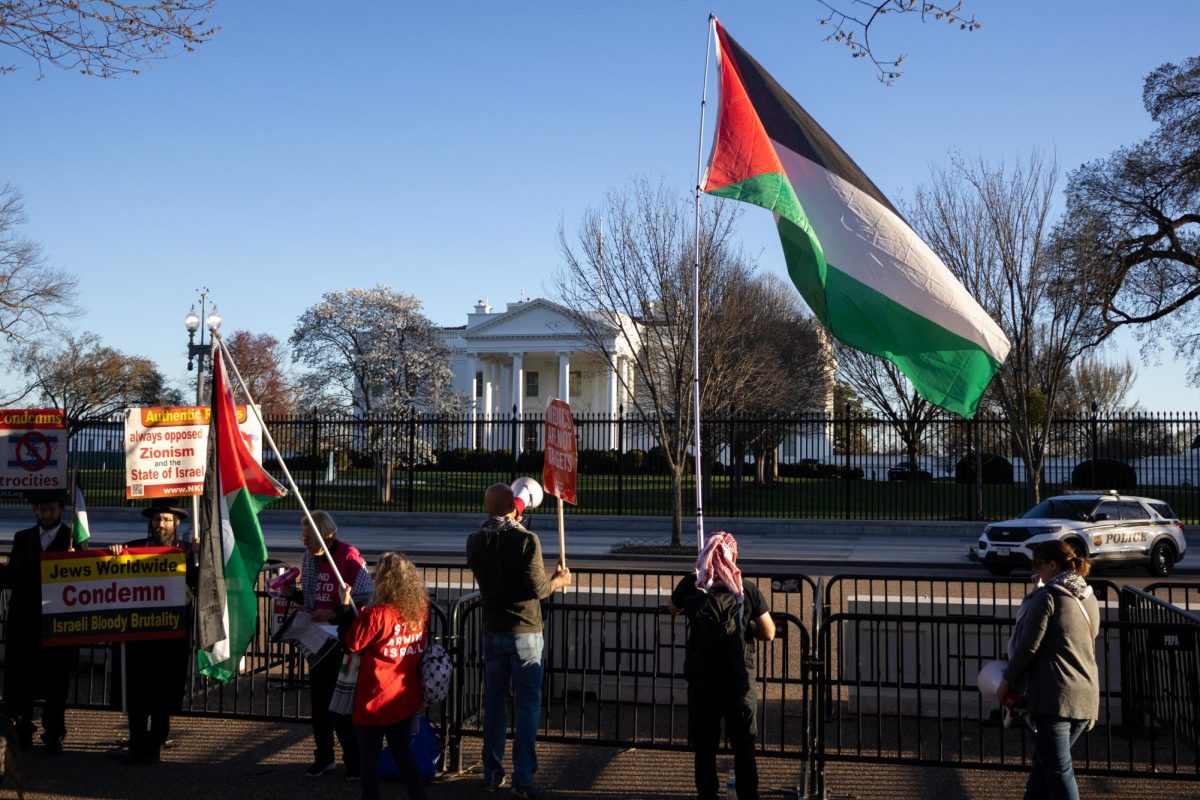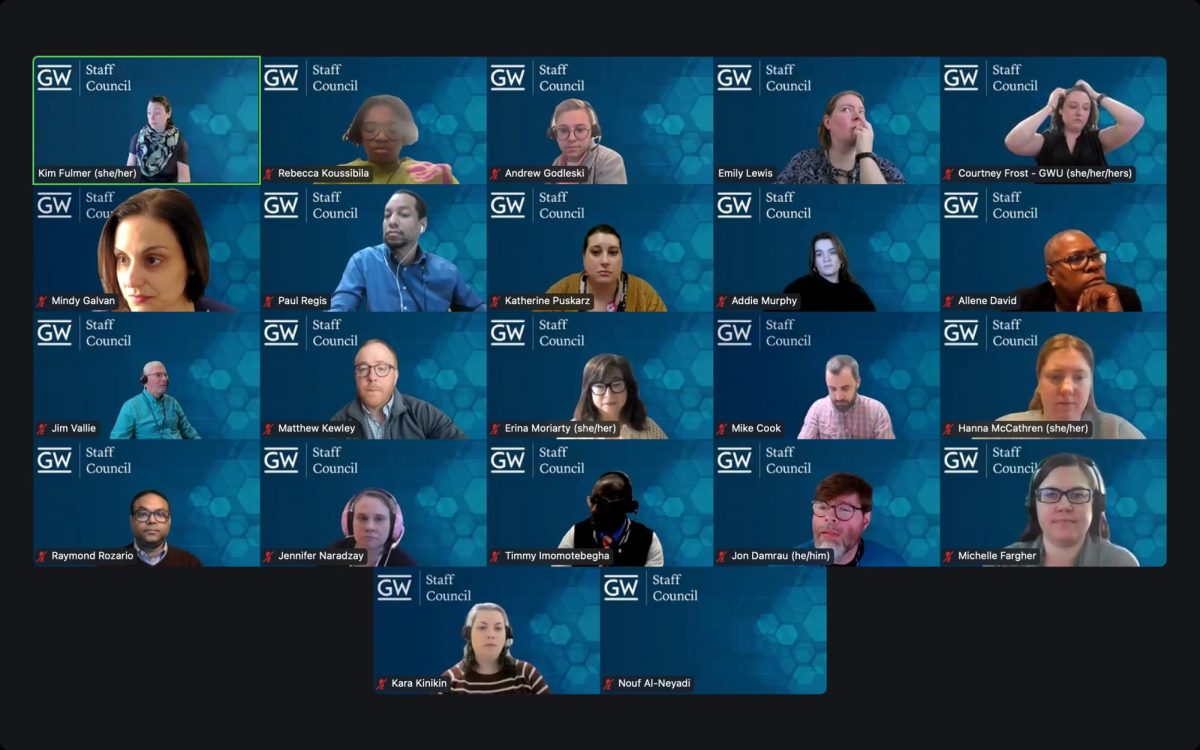
For the last few years, a joke has floated around some offices in Rice Hall: While Stephen Joel Trachtenberg woke up every day excited to be University president, Steven Knapp wakes up and wonders what will go wrong.
The quip is a commentary on the personality differences between GW’s last two presidents, a top administrator said.
But Knapp has, in fact, found himself on the defensive for a new reason every few months since his contract was renewed two years ago. The University has battled two admissions scandals, a dean firing at one school and a plot to oust the dean of another, failed plans to open a campus overseas and student backlash against an on-campus housing mandate.
But Knapp seems to have found his balance among the inevitable highs and lows of a modern university presidency. In the past month, he has accepted $80 million worth of gifts for GW’s public health school, planned the acquisition of D.C.’s largest private arts institution and celebrated the men’s basketball team’s best season since 2007.
“Everyone in the GW orbit is bolstered by this. It’s like, ‘Wow, we’re on a roll.’ This momentum is real,” the University’s chief fundraiser, Mike Morsberger, said.
Shaking off negative publicity and a year during which GW pulled in fewer donations, Knapp has hit his stride at the right time as GW prepares to launch a fundraising campaign that will likely total $1 billion.
For a University trying to overcome decades of sluggish fundraising, a president with a polished image could make all the difference. Knapp said in an interview that it takes strong deans and programs to catch the eye of potential benefactors, but the University president can make or break the deal.
“A donor is not going to want to invest in an institution unless they have confidence in the leadership of the institution. They want to make sure that their gift is going to succeed,” Knapp said. “They want to know the president because they want to know who the president is and want to know whether they can trust the president to pull it off.”
GW has fallen short in fundraising compared to top research schools, with its largest gift totaling only $25 million until this year. But the public health school announced March 10 that it received $80 million from the foundations run by Michael Milken and Sumner Redstone to support research on chronic diseases.
The gift came just as GW’s fundraising office plans to launch a massive campaign to boost research, faculty, financial aid and capital projects, similar to an effort Knapp helped lead as provost of Johns Hopkins University.
The Board of Trustees uses fundraising as a yardstick to evaluate Knapp’s performance. The group, made up of alumni, donors and business leaders, determines his salary and bonus levels partially based on the progress he has made toward goals set by Knapp and the board.
Knapp earned $1.108 million in the 2012 fiscal year, the third-straight year his total compensation surpassed $1 million. His contract with the University, which was last renewed by the board in 2011, also depends on headway he’s made in advancing GW’s academic reputation and fundraising.
“It’s certainly been my experience that once you start attracting philanthropy at the level we’re now attracting them, that does tend to grow,” Knapp said. “I think now it’s no longer the case that people won’t be thinking of us as the kind of place that gets that kind of gift.”
Less than a month before the gifts, GW announced a merger with the Corcoran College of Art + Design, giving the University its largest academic takeover and campus space across from the White House. The partnership set off a wave of national attention, with the University earning praise for rescuing the financially stressed art school and gallery.
Knapp has said that his administration’s 10-year strategic plan aims to turn GW into a “hub for the arts and culture” of D.C., which could attract more donors with interests in the arts.
But some plans to raise standards and grow the University’s reputation have backfired.
A wave of negative attention hit GW last year, when U.S. News and World Report took GW off its list of best colleges after the University revealed that it had inflated admissions data for at least a decade.
The admissions office came under scrutiny again this past fall when its new leader admitted that for years, GW has waitlisted hundreds of undergraduate applicants who can’t pay the full cost of tuition. Knapp has said the University’s efforts to be transparent outweigh the scandals.
Meanwhile, GW scrambled to do damage control: The deans of two of its top schools had their tenures cut short by faculty strife and budget mishaps, the University’s supposed “rich-kid reputation” was splashed inside the Washington Post, and a local news program based a segment on a Facebook page called “GW Housing Horrors” about moldy living conditions in a GW residence hall.
“At any big, complicated university, somebody is going to mess up. It doesn’t matter how brilliant the president is. The question is, what does the University do when somebody messes up,” said Scott Jaschik, the editor of the news website Inside Higher Ed.
Knapp has described some of the bad publicity as growing pains of GW’s ambitious agenda. At a University that has grown immensely over the last few decades, Knapp maintained that his administration has laid a solid foundation that can handle administrator turnover and public scrutiny.
“It’s a big organization and there is a lot to worry about, the lives and education of 25,000 kids and thousands of employees. So many things can go wrong,” Morsberger said. “But I think he’s able to compartmentalize it to the extent that I don’t think any of these things have ever paralyzed him.”
Charting a new direction
Knapp, who served as vice president of academic affairs and provost at Johns Hopkins University for a decade, came to GW with plans to transform the University into a top research institution.
That vision began to take shape over the last year through a $300 million strategic plan. The decade-long plan that stresses interdisciplinary research, international education and faculty hiring across school is the result of years of discussions led by Knapp’s second-in-command, Provost Steven Lerman.
“When you first come into office, because the institution is not used to rapid change and transition at the presidential level, it sometimes takes two, three, four years until that person’s agenda takes over,” said Robert Chernak, the University’s former senior vice president for Student and Academic Support Services.
Part of Knapp’s strategy to recruit top faculty and researchers involves building facilities to support their work, including a $75 million home for the public health school and the $275 million Science and Engineering Hall.
To build up research inside those buildings, Knapp recruited Leo Chalupa as the University’s first research office chief. Chalupa, who reports directly to Knapp, meets with him one-on-one, sometimes once a week, to come up with strategies for winning more research grants and boosting GW’s name. The focus appears to be paying off, as the University attracted 10.8 percent more outside dollars for research last semester.
Chalupa said the president has made it a point to personally meet with the directors of GW’s research centers – like the Computational Biology Institute and the Global Women’s Institute – who are often the best in their fields and likely to bring in hefty grants.
“He said, ‘I want you to build research here,’ so he sets the tone,” Chalupa said.
But the investments have come with risks. Plans to fund the projects, which have totaled a half-billion dollars since the beginning of Knapp’s tenure, have set off a borrowing binge and put pressure on the University to step up fundraising and win more government subsidies to pay off debt.
Letting down his guard
Knapp arrived at GW in the shadow of Trachtenberg, a 19-year president who often walked around the campus and chatted with students on park benches.
A top administrator – who asked not to be named – called Knapp “relentless” when it comes to defending the University’s image, a leader who constantly examines and reexamines what he says and writes. But that can cause students, donors and employees to see the former English professor as unapproachable.
Knapp seems to have “a three-point plan” for every response, instead of “accepting criticism” or showing vulnerability, the administrator said.
Now, Knapp has had more candid moments as he’s settled into his role, meeting with Student Association leaders in J Street and cracking jokes in University-produced videos to name the new $130 million residence hall.
He also became a fierce advocate for the SA’s plan to move GW’s health centers to campus. Susuni said Knapp personally called her when he decided last November that the University’s health centers should relocate to campus, an unanticipated and costly move that will take place by early 2015.
Chernak, who is now an associate professor of higher education administration at GW, said the transition from Trachtenberg to Knapp marked a shift in priorities and personality, which some have misinterpreted as more closed off.
“Maybe students are feeling a lack of some love on the part of the senior administration,” Chernak said. “In reality, that’s not true. It’s a style of leadership that’s different.”
– Cory Weinberg and Mary Ellen McIntire contributed reporting.






